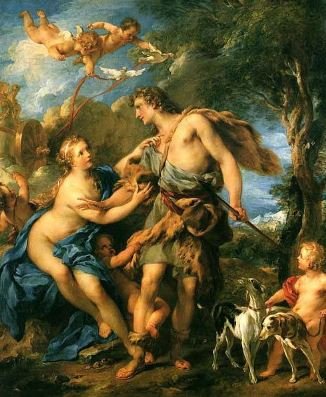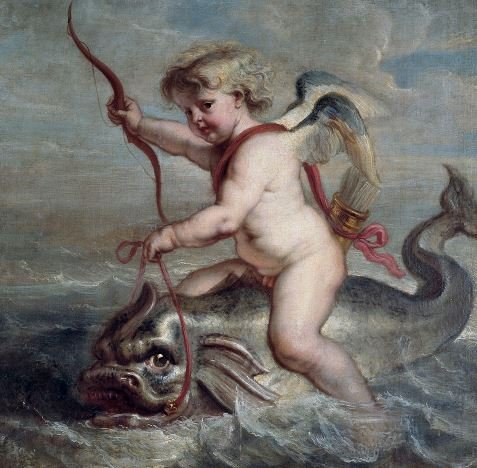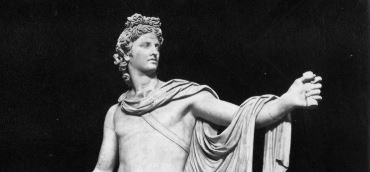Aphrodite in Greek Mythology – Birth Story, Meaning, Symbol, Powers, & Abilities

Aphrodite in Greek Mythology. Painting – The Birth of Venus (c. 1485) by Sandro Botticelli
With regards to the affairs of love, sex and beauty, the ancient Greeks took to revering the Olympian goddess Aphrodite. The most famous origin story of Aphrodite states that she emerged from the genitalia of the god Uranus that was cast into the waters off the coast of Cyprus. Being one of the Twelve Olympian gods, she was said to have such a beauty that was unmatched anywhere on earth or in the heavens. With the ability to make both mortals and gods fall in love, Aphrodite was often depicted in Greek mythology as the “fairest of them all”.
A true mistress of illegitimate affairs, Aphrodite had several children, including Eros (Cupid), Harmonia, Phobos, and Peitho. In addition to issues of love and beauty, the goddess she was seen in a favorable and reverent light by ancient Greek sea travelers, warriors, prostitutes, city administrators, politicians, and traders. In Rome’s pantheon, Aphrodite was the equivalent of the deity Venus.
How was the goddess Aphrodite born?
For millennia, the story behind Aphrodite’s birth has been taken from two main origins.
The first origin story comes from Hesiod’s Theogony. Hesiod states that the goddess of love and beauty emerged from the foam-covered waters (aphros) of Paphos around the Cyprian island (island of Cypress).
The Theogony goes on to say that Aphrodite’s birth was triggered after the castrated genitalia of the sky god Uranus fell into the sea. The castration was done by Cronus, Uranus’ son, using a sickle given to him by his mother Gaia, the goddess of the Earth. Upon hitting the sea, a thick layer of foam formed and out came Aphrodite from a scallop shell – a fully-grown and beautiful goddess.
However, in Homer’s Iliad, she is considered the daughter of Zeus and Dione. Dione was a Titan goddess and part of the early gods. She once helped heal Aphrodite after the goddess of beauty was injured in the Trojan War.
“Heavenly Aphrodite” versus the “Pandemic Aphrodite”
According to the Greek philosopher Plato, the goddess in both the Iliad and the Theogony refer to two entirely different Aphrodites. The great philosopher stated in his Symposium that the goddess from the first origin story, the ‘Heavenly Aphrodite’ (Aphrodite Ourania), was in charge of the love and affection that men had for one another. He described this higher form of love as a “spiritual love”. This Aphrodite also encourages the race of mortals to pursue knowledge and harmony.
On the other hand, the second origin story referred to the ‘Pandemic Aphrodite’ (Aphrodite Pandemos) – a goddess that managed the love between men and women. This love was considered base and in some cases vain. It only involved the body and had nothing to do with the soul.
In a separate account, the Athenians that worshiped Aphrodite Pandemos, believing that she was in charge of granting love and harmony in civil and political issues of the city. This view of Aphrodite is generally referred to as the “Common Aphrodite”.
Aphrodite’s Marriage to Hephaestus
Aphrodite’s beauty caused a lot of friction and animosity to build up among the gods on Mount Olympus. As a result, the all-powerful king of Olympus, Zeus, decided that it was best Aphrodite tied the knot, least the rivalry and envy among the gods spilled into a war.
Zeus married Aphrodite off to Hephaestus, the lame and hideous-looking god of fire, forges and metals. This decision of Zeus came as a huge shock to many Olympian gods. Zeus believed that the marriage would help reduce the chaos that was brewing on Olympus due to Aphrodite’s beauty.
No sooner had the two taken their marriage vows, than Aphrodite began her illicit affairs with the gods on Mt. Olympus. Rumors of Aphrodite’s long list of lovers spread like wildfire. On that list were also mortal men of whom the goddess of love and beauty hopelessly fell in love with.
Aphrodite’s lovers and infamous affairs
Regardless of her marriage to Hephaestus, Aphrodite was occasionally bombarded with lots of attention and admiration from the gods as well as mortals. The following are some very notable affairs that she had:
Aphrodite and the god Ares

Mars (Ares) and Venus (Aphrodite) Surprised by Vulcan (Hephaestus) | Painting by Alexandre Charles Guillemot (1827)
Aphrodite’s romantic affair with Ares, the god of war, came as a huge surprise to the Olympians. Who would have ever thought that the goddess of war will fall in love in with someone who was completely antithesis to her. It is believed that she took to liking Ares because of his aggressive personality and desire to always win. The relationship they had is comparable to the concept of yin and yang – positive and negative; dark and light; and hate and love.
Getting wind of Aphrodite’s unfaithfulness, Hephaestus developed a plan to expose his wife. The master of forger planted a mechanism just below the bed of Aphrodite. And just as he intended, the mechanism activated and entrapped Ares and Aphrodite when they were in bed, thereby exposing them to the full glare and ridicule of other gods and goddesses. Hephaestus also contracted the sun god Helios to cast his light upon the couple once the mechanism activated.
Eros, Anteros, Phobos and Deimos are just some examples of the children that were borne out of the union between Aphrodite and Ares.
Aphrodite and Dionysus
This union produced Charites (or the “graces”); the heavenly deities of Aglaea (“Beauty”); Euphrosyne (“Mirth”); and Thalia (“Good Cheer”). Many of these deities stayed very close to Aphrodite.
Aphrodite and Anchises
After an affair with the mortal and shepherd Anchises, Aphrodite gave birth to Aeneas and Lyrus. Anchises loses his eyesight after he was struck by lightning. It is believed that Anchises met this sad fate because he revealed the name of his son’s mother. On the other hand, Aeneas went on to become a great Trojan warrior in his own right. Right after Troy capitulated to the Greeks, Aeneas went on to establish the city of Rome.
Aphrodite and the mortal Adonis

Aphrodite tries to prevent Adonis from going hunting. Painting – Venus and Adonis (1729) by François Lemoyne
Adonis’ beauty and manliness were enough reasons for Aphrodite to fall in love with the mortal. Fearing that the young mortal might be snatched by some other goddess, Aphrodite gently placed Adonis in a magical chest that she tasked the queen of the underworld Persephone to protect. As time went by, Persephone got enamored of the beauty of Adonis and fell in love. She later decides to keep Adonis for herself. A bitter tug of war soon erupts between Aphrodite and Persephone over who had the right to keep Adonis.
Zeus then steps in to mediate the issue. Zeus strategically splits the year into three and commands that Adonis spends four months with Aphrodite and the second four months with Persephone. The remaining four months of the year, Adonis is asked to spend by himself.
In the end, Aphrodite was left completely shattered upon the death of Adonis during a hunting accident. In her grief, she cast a magical spell on Adonis’ body, turning him into a scentless flower.
Aphrodite’s Children

One of Aphrodite’s children, Eros (Cupid), the god of love. Painting – Cupid Riding on a Dolphin (1630) by Erasmus Quellinus II
The goddess of love and beauty had quite a number of children – deities and mortals. Surprisingly, none of her children came with Hephaestus, her husband, and half-brother.
The most significant child of Aphrodite has to be the god Eros (Cupid in Rome’s pantheon). Other children of hers are Harmonia, the goddess of harmony and balance; Deimos, the god of dread; Phobos, the god of fright; Eryx, the Sicilian king; Priapus; and Aeneas, the Trojan War hero.
Majority of her children came with Ares, the god of war. Examples of these offspring are Eros, Harmonia, Phobos, and Anteros.
Her affair with Dionysus also produced Hymenaios and Priapus. The former was the god of marriage ceremonies, and the latter was the god of fertility who had large genitalia.
With Adonis, Aphrodite gave birth to Bero (Beroe) and Golgos. Furthermore, her affair with Poseidon, the god of the sea, produced a nymph called Rhode. Rhode was considered the goddess of the island of Rhodes who would later go on to become the wife of Helios, the sun god.
Hermaphrodites, Tyche, Peitho, Eunomia, and Tyche were some of the children that emerged from Aphrodite’s affair with Hermes, the messenger god. Amongst those children of hers, she had the closest relationship with Peitho, the god of persuasion. As a result, ancient Greeks often called upon Aphrodite and Peitho to intercede during political deadlocks and other social interactions.
Aphrodite’s Powers, Attributes and Symbols

Aphrodite’s greatest power was love. On all matters pertaining to love, desire and affection, the goddess came out top. She had the rare ability to make others fall in love with her. She also had a magical girdle that gave the holder the ability to make anyone, mortal or god, fall in love. Other very famous symbols of Aphrodite are the pomegranate, scallop shell, myrtles, a magical girdle, and a mirror. It is interesting to note that virtually all the symbols of her are associated with beauty and aestheticism.
The Judgment of Paris and Aphrodite’s Role in the Trojan War
The Trojan War was the handwork of Eris, the goddess of strife. The story began at a beautiful party that celebrated the marriage between Peleus and Thetis. All the major gods and goddesses graced the occasion. There were also prominent kings and queens from the realms of men.
As the party was just about ending, Eris left behind a golden apple – an apple like never seen before. In Eris’ parting remark, she said that the golden apple was to be given to the “fairest” of all the goddess.
With the goddesses Athena, Hera and Aphrodite all vying for the golden apple, a ruckus broke out. Who among those goddesses could lay claim to such a beautiful golden apple?
To make peace reign, Zeus instructed the mortal Paris of Troy to sit on the case. Zeus picked Paris as the judge because he was less likely to be influenced by any of those three goddesses that vied for the apple.
As the case proceeded, Athena went on to bribe Paris by promising to bestow on him wisdom and strength like never seen before – wisdom far beyond the limits of mankind.
Hera, on the other hand, promised blessing Paris with complete power over all nations on the earth. This unbridled power would have left Paris the overall ruler of places in Asia and Europe.
Finally, Aphrodite tried to lure a favorable decision from Paris by promising him the most gorgeous woman in all the realms of man – Helen of Sparta.
Paris, overcome by the extreme beauty of Helen, made the decision in favor of Aphrodite. Eris’ golden apple was therefore given to Aphrodite. Unfortunately, Helen of Sparta was the wife of Menelaos. Considering this an attack on his honor, Menelaos readied his ships and declared war on Paris and the Trojans. He was joined by his brother, King Agamemnon of Mycenae. Together, the two marched their army towards Troy, marking the beginning of the most legendary war in Greek mythology, the Trojan War.
Staying true to her word, Aphrodite supported the Trojans during the war. Homer’s Iliad goes on to say that she proved instrumental in saving Paris from the wrath of Menalaos.
How Aphrodite became jealous of Psyche
Psyche was a beautiful mortal princess who suffered the ire of Aphrodite simply because people from all over ancient Greece would come to her city to catch a glimpse of her. Some of Psyche’s admirers even compared Psyche’s beauty to Aphrodite’s and started worshiping psyche instead. As punishment, Aphrodite tasked her son Eros to make Psyche fall in love with the ugliest looking man in the world. However, just before Eros could fire his magical arrows, he mistakenly fired them into himself. Eros subsequently fell in love with Psyche.
After several years of test from Aphrodite, Psyche and Eros eventually got married on Mt. Olympus. As part of a wedding gift to Psyche, Zeus made Psyche immortal. The two couples lived on Mt. Olympus for eternity. They bore several children. Most famous of those children was the goddess of Pleasure (Volupta in Roman mythology).
Aphrodite’s Weakness
The Aphrodite’s greatest weakness was her inability to control her temper whenever anyone, mortal or goddess, tried to rival her beauty. She would burst into fits of rage and jealousy whenever a mortal’s beauty was in any way compared to her beauty.
Ancient places that worshiped Aphrodite
All across ancient Athens, Cytherea, and Cyprus, Aphrodite received large cult following and admiration from the people. Cytherea was considered the exact place she passed by in order to fully emerge at Cyprus. As a result, there were numerous temples and shrines littered all across those places in honor of her. In Cyprus, she was considered the great goddess of the city.
Over the years, it has also been revealed that the ancient city of Odessus was a huge and thriving hub for the worship of Aphrodite.
Generally speaking, the kind of reverence the ancients gave to Aphrodite was a bit more personal and intimate. It bordered on issues pertaining to building love, harmony, and mutual relationship.
Aphrodite was often heralded as the goddess that people prayed to when their relationships needed to be mended. It is for this reason why she is often called upon for unity and agreement – elements that are vitally needed in every human interaction, be it trade, politics, warfare or marital issues. Whenever two conflicting parties needed to put aside their differences and work, it was not uncommon for them to pray to Aphrodite. They would ask for something called the mixis (‘mingling’) from the goddess. As a result of this, she was considered a huge player in seeing to it that the Athenians had a stable democracy or political discussion.
Depiction in art and culture

The Crouching Aphrodite
Over the centuries, Aphrodite has been shown in a multitude of ways and classical ancient arts. The only trait that runs through all those depictions is that she is painted or sculpted wearing beautiful garments of Cyprian or Archaic origins. She does not have any specific feature or attribute.
Most of her statues (after the 4 BCE) were made to show her nude, or in some cases semi-nude (example, the Venus de Milo). Her features are also in a very symmetrical manner.
More often than not, she is identified holding an apple, supposedly Eris’ golden apple that she won in a contest. In some cases, she’s shown riding a goose or a swan with a girdle (belt) around her waist.
In almost all cases, she has been seen as young and full of eternal beauty, flying a chariot pulled by sparrows.
A great number of the statutes and sculptures of the goddess Aphrodite (or Venus) crouching were in vogue during the ancient times, particularly the Hellenistic periods. Many of those of sculptures depict her in bath or crouching position. Again, this is a subtle reference to her birth story. Hence, the goddess’ stories and sculptures always try to pay homage to the sea (water) that she emerged from.
The Venus of Cnidos, sculpted by Praxiteles in the 4th century B.C., is considered the most famous of Aphrodite’s statues.
The significance of Aphrodite
Even before the Greeks emerged, Aphrodite had long been seen as a crucial figure in the world of lust and love of popular and advanced cultures. Her stories had an immense effect on the Sumerians, Mesopotamian, and the Syro-Palestinians. In civilizations around Mesopotamia, for example, there was the goddess Ashtart (sometimes called Astarte or Ishtar). Goddesses like Ashtart were primarily responsible for both war and love.
What the above means is that the Greeks were not the first to have a goddess that had traits like that of Aphrodite.
And because there was such an immense fascination with the female body, Aphrodite’s role in the affairs of the ancients was much more pronounced in their cultures than she is in present-day/western monotheistic periods. Regardless of this, her myths and stories continued to be a huge source of inspiration to Renaissance artists and thinkers. For example, in 1486, Sandro Botticelli brilliantly painted the goddess in an amazing painting called the Birth of Venus.



























